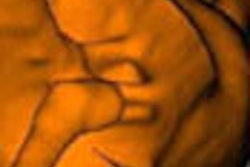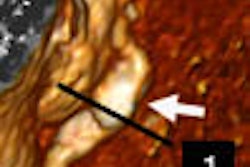VANCOUVER - Virtual colonoscopy is a relatively noninvasive examination and is clearly less risky than invasive colonoscopy, according to a study presented at the American Roentgen Ray Society (ARRS) meeting this week.
The safety profile for virtual colonoscopy (VC) is extremely favorable, particularly for screening asymptomatic patients and when distending the colon using an automated carbon dioxide technique -- a finding that contradicts higher complication rates for the exam reported by other groups, according to the study authors.
"The overall complication rate has really not been well-established, except for anecdotal case reports in small series from other countries, with a couple of groups recently reporting relatively high complication rates -- not to the point of optical colonoscopy, but higher than one might suspect," said Dr. Perry Pickhardt.
Pickhardt, from the University of Wisconsin Medical School in Madison, presented the results of a retrospective study of the safety of virtual colonoscopy from 21,923 diagnostic and screening procedures performed between 1997 and 2005. The survey was conducted from the Working Group on Virtual Colonoscopy (WGVC), with respondents comprising 16 medical centers in five countries. A total of 11 facilities reported conducting at least 1,000 examinations.
"A slight majority of (VC) studies (53.4%) were labeled as screening and the remaining (46.6%) studies were diagnostic," Pickhardt noted.
The primary measurement outcomes included the symptomatic perforation rate and the overall significant complication rate, which was defined as any potentially VC-related event leading to hospitalization, according to Pickhardt. Data were also collected on the number and type of VC studies performed, colonic distension technique, and presence of a monitoring physician, he said.
Direct physician monitoring of VC studies was reported in 45.8% of cases, with individual center practices ranging widely, from a low of 0% to a high of 100%, Pickhardt said.
Colonic distension was achieved by manual room-air insufflation in 59.6% of surveyed cases (directly controlled by the patient in 12.7% of the cases) and automated carbon dioxide delivery in 40.4% of the total studies surveyed, the researchers reported. Significantly, no perforations were recorded in patients undergoing screening VC or with those who underwent the automated carbon dioxide delivery technique.
Perforations were recorded in only two patients undergoing diagnostic VC, and manual room-air insufflation by the staff was employed in both cases. According to Pickhardt, one patient was asymptomatic and neither hospitalization nor treatment was required. The second patient was hospitalized and treated but was already symptomatic prior to VC due to annular sigmoid carcinoma, and received only two to three puffs of air before the procedure was suspended. The symptomatic perforation rate was stated as 0.0046%, or 1 of 21,923 VC procedures.
Three additional patients were admitted following VC, two for acute renal failure related to prep and one for chest pain. Overall, the researchers found that the complication rate for VC in the survey was 0.018%, or 4 out of 21,923 procedures.
No perforations were recorded in patients undergoing screening VC or in those who utilized automated carbon dioxide delivery for insufflation. According to Pickhardt, automated carbon dioxide delivery is much simpler and safer for the CT technologist to employ than manual room-air insufflation, which was the distension method used in the studies that reported perforation complications.
"The automated nature of carbon dioxide delivery removes the guesswork and patient coaching necessary with manual distension," Pickhardt said. "In addition, this automated approach with low-pressure carbon dioxide provides improved distension and reduced postprocedure discomfort."
The multicenter, multinational WGVC survey conclusively demonstrates an extremely favorable safety profile for VC, particularly for asymptomatic screening and automated carbon dioxide insufflation. Pickhardt noted that higher complication rates reported by other groups may be due to factors of patient selection and the reported use of long-outdated distension techniques.
"Our results provide reassurance to patients that this minimally invasive examination is a very safe colorectal screening tool," he said.
By Jonathan S. Batchelor
AuntMinnie.com staff writer
May 5, 2006
Related Reading
Adverse events weigh on colonoscopy mortality equation, February 6, 2006
Study suggests vasovagal reactions are rare in VC, December 14, 2005
VC safe, surveys show, but not without incident, October 18, 2005
Copyright © 2006 AuntMinnie.com



















